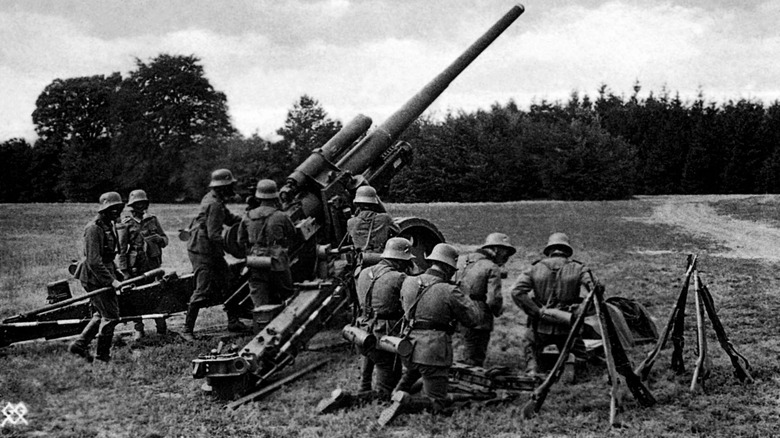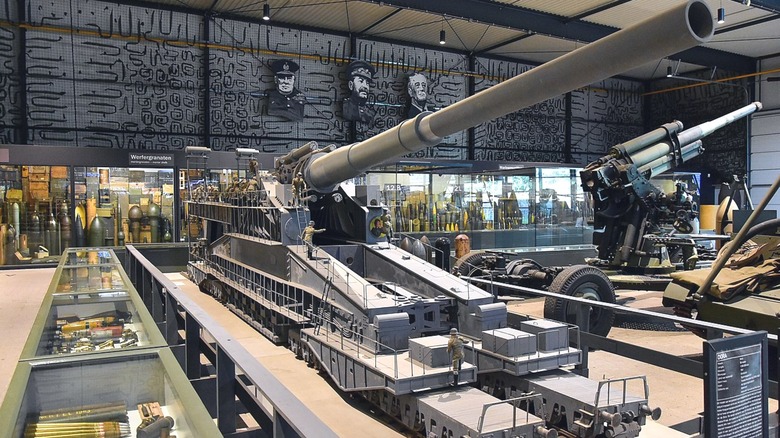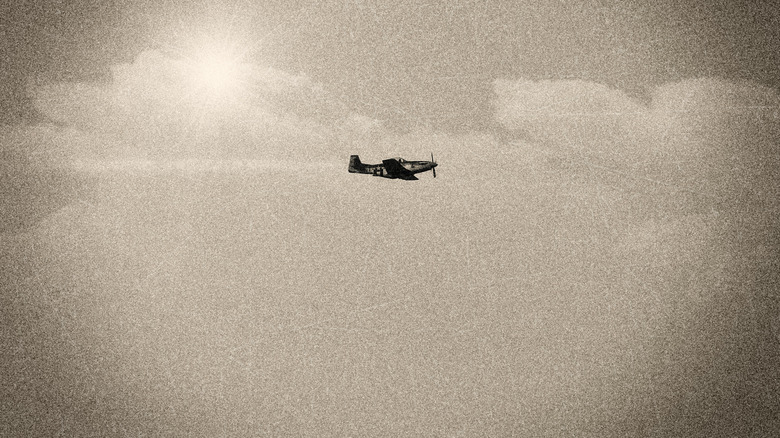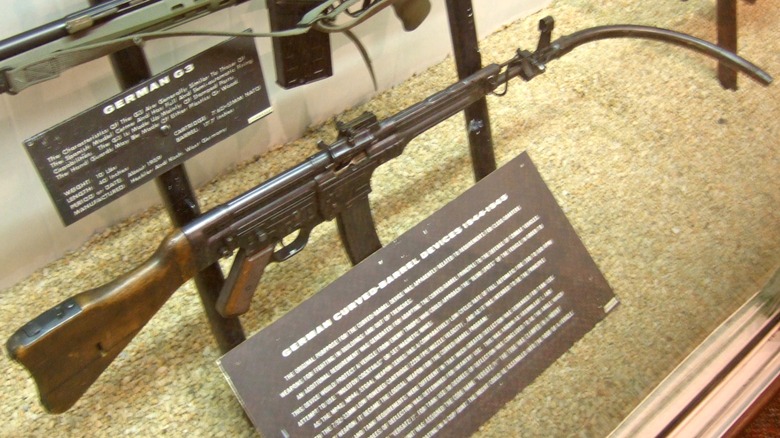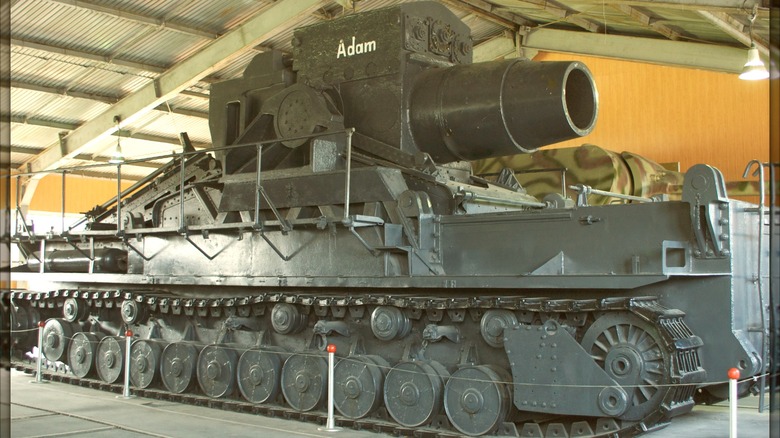The Craziest Military Machines Invented By The Third Reich
There's no denying that Adolf Hitler had some massive ambitions during his time as Germany's Chancellor, and this often resulted in the construction of some outlandish machines under the Wunderwaffe (wonder-weapon) program. Hitler wasn't the type of leader to go for just any old artillery piece — he had to have the largest ever built, which could only be moved on rails! That, and more, were put together by German engineers, and the result was often disastrous or impractical.
That's not to say the Nazis didn't craft some seriously impressive military hardware — they gave the world the first modern working rockets used in war, with the successful V-2, as well as the first single-engine jet fighter.
Throughout World War II, Hitler's war machine created havoc in Europe and Africa, and in many cases, the Nazis tried using innovative means to accomplish their goals. Some of these worked, while others most certainly didn't. While many crazy military machines came out of the Third Reich, these five rank among the most ridiculous, though their concepts were surprisingly sound, even if their execution was not.
The Gustav Gun was the largest ever built
While Hitler loved things to be excessively large, nothing compares to the Schwerer Gustav gun, the largest gun ever used in combat. Development began in the late 1930s, with the creation of a siege artillery weapon that was so massive it required rails to move it around. The purpose of the Gustav gun was to breach the Maginot Line, France's heavily fortified border with Germany. Unfortunately for the French, the Germans went around the Maginot Line through Belgium and the Netherlands, making the Gustav gun unnecessary.
It was still an operational railway gun, and the Nazis were happy to use it. The massive weapon weighed 1,350 tons, and was deployed against the Soviet Union in the Battle of Sevastopol. The gun's specifications were incomparable and remain so. The 106.8-ft barrel fired a 31-inch-wide, 12-foot-long armored-piercing or high-explosive shell. It had a terrible rate of fire, only managing to fire one round every 30 to 45 minutes.
The Gustav gun also required a massive force to move and assemble it over a period of three days. It took 250 personnel to operate and fire, while it took more than a thousand people just to assemble and put it in place. It was also accompanied by anti-aircraft artillery, meant to protect the weapon from air attack. The gun's most impressive feature was its range of 29 miles. Ultimately, the Schwerer Gustav was effective, but its use was impractical for continued use throughout the war, and it only fired a few dozen rounds in combat.
[Featured image by Paul Hermans via Wikimedia Commons | Cropped and scaled | CC BY-SA 4.0]
Germany developed a Wind Cannon
The use of airplanes in combat began in 1911, during the Italo-Turkish War, but by WWII, the air war was one of the most decisive elements of the conflict. Gaining air superiority was a priority for the Nazis as well as their enemies, and there were several methods available to deter aircraft at the beginning of the war. Ground-based air defenses consisted of anti-aircraft artillery firing flak at predetermined altitudes, but this wasn't always effective.
The Germans conducted research into alternate methods of air defense, including using air itself as a weapon. You might not think of bursts of air as particularly dangerous, but the Nazis had lofty ideals in the construction of their Windkanone (Wind Cannon). The weapon consisted of a large, angled barrel that could be aimed at a specific spot in the sky. Igniting a mixture of hydrogen and oxygen created a powerful burst of air that was directed through the barrel.
Tests proved the concept, though not against flying aircraft. The Wind Cannon successfully blasted a wooden board at 200 meters (656 feet), which was impressive. Unfortunately for the weapon's designers, it wasn't as practical to use against a moving aircraft as it was against a stationary piece of wood. Despite this, it was installed on a bridge over the Elbe River, but never succeeded in taking out any targets.
Germans used a Curved Barrel to shoot around corners
Since the invention of the firearm, nations have worked to reinvent and perfect the design, and one of the most desirable upgrades has always been to shoot around corners. This eliminates the danger posed to the person firing their weapon, but actually designing a weapon capable of firing around corners is no easy task, as bullets don't fire best through anything but a straight barrel.
The Nazis created the Krummlauf (Curved Barrel) as an attachment for the Sturmgewehr 44 assault rifle. The attachment came with a periscope that enabled the firer to look around the corner to see their target. The curved barrel technically worked and was relatively effective with 30 and 90-degree barrels, though the 30-degree model was the only one widely produced during the war. The main problem was that the curved barrel resulted in higher than normal temperatures, reducing the barrel's lifespan.
The temperature limited the total number of rounds that could be fired through the Krummlauf. The 30-degree version could fire around 300 rounds, while more significant options were more limited. Also, the bullets often broke apart before leaving the barrel, and the weapon was inaccurate. Despite these limitations, the weapon was used, and it inspired numerous copies with several modern options that built on the Krummlauf's original design.
[Featured image by Joe Loong via Wikimedia Commons | Cropped and scaled | CC BY-SA 2.0]
The Karl-Gerät was a massive siege mortar used in combat
Adolf Hitler's love of all things ridiculously large manifested in several armor designs that defied practical use in combat. One such vehicle, the Karl-Gerät, was a self-propelled siege mortar capable of firing massive shells. Each Karl-Gerät weighed between 124 and 139 tons, depending on configuration, and sported a massive barrel measuring 20 feet with a caliber of 600 mm, or 24 inches. This enabled the Karl-Gerät to fire massive ordnance a distance of around 2.6 miles for the 24" barrel or 6.25 miles for the 21" barrel's 254 mm caliber round.
The rounds for the Karl-Gerät weighed as much as 4,780 lbs. with some lighter ammunition weighing a little more than half as much. Before the war ended, Germany constructed seven Karl-Geräts, and six saw combat in several notable offenses, including the Battle of the Bulge, the Battle of Remagen, and in several places in Poland and the Soviet Union, including Ukraine.
While the Karl-Gerät proved useful and was an effective indirect fire weapon, it wasn't used for its intended purpose, which was to break through the Maginot Line. Also, it required far more than a single vehicle to operate. The weapon had a top speed of six mph, requiring transportation on railcars to a battle. It used its own locomotion for minor repositioning for targeting, and the weapon required heavy railcars, a crane, and modified tanks to carry ammunition. This made it impractical in most engagements, and is another example of the Nazis going too big to achieve something a smaller, more efficient weapon could already accomplish.
[Featured image by Ruslan Salikhov via Wikimedia Commons | Cropped and scaled | CC BY-2.0]
The Nazis planned to use the sun as a weapon
While the Nazis never shied away from creating truly massive machines, some were well outside the realm of possibility, despite the idealized effectiveness of such devices. The Sonnengewehr is a weapon system that was designed, but never realized. Also called the Heliobeam or Sun Gun, the Sonnengewehr was a theoretical space station developed from a concept created by German physicist Hermann Oberth in 1929.
During World War II, the proposal for the Sun Gun was dusted off, and plans were made to create the device. If realized, the Sun Gun would have manifested as part of an orbital space station 5,100 miles above the surface of the Earth. Using a huge mirror made of metallic sodium, measuring 3.5 square miles, the Sun Gun could concentrate solar energy and direct it through a focusing mechanism at a target.
Theoretically, the Sun Gun could have boiled oceans or destroyed whole cities, so it was something the Nazis hoped to build. Despite this, they were well aware of their limitations and believed they could create the Sun Gun within a century. That may sound like a long time, but the Third Reich had lofty goals of global domination, so in the grand scheme of their plans, the Sun Gun was a challenging future possibility.
[Featured image by Tabitan via Wikimedia Commons | Cropped and scaled | CC BY-SA 4.0]
